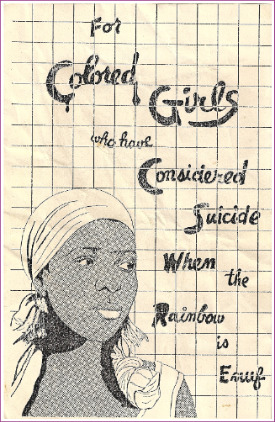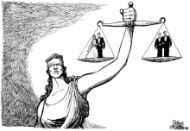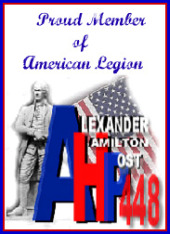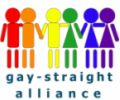
Program cover for the production of "For Colored Girls" given at the Purple Masque Theatre at Kansas State University in early spring of 1979.
A recent revelation about how much money the Knights of Columbus had given NOM (the anti-gay group that spends millions to fight against same-sex marriage, but goes to court trying to avoid telling where it gets its money) helped bring back some memories of my coming out days at Kansas State University in Manhattan, Kansas. (Yes, you New Yorkers, there is another Manhattan, and Dorothy actually lived there, a number of them, in fact!)
After I got out of the Air Force (read about Greece and the 6916th here and here), I spent three years working in northwest Kansas and lived in a town of about 200 people, and back in those days, when Bachman-Turner Overdrive was cranking on the radio, it wasn’t exactly the environment for a guy still trying to figure himself out.
Even though I loved the people out there in the sticks in Sheridan and Thomas counties, you know what they say about the lure of the bright lights. Those lights were a couple hundred long miles down I-70 in Manhattan, Kansas, where I started graduate work in theatre. I had this idea that I was going back to school to become an actor, but looking back on it, unwittingly, I was looking for a place comfortable enough to find “me”.
And it didn’t take long to find that place. I was barely starting classes when I got cast as Dr. Rank in the KSU production of Henrik Ibsen’s “A Doll’s House” and about the same time, a guy in one of my classes invited me to a party, and “that,” as we say, “was that.”
I appeared in and worked on a lot of theatre and other productions during my time at K-State. I also found a group of gay “brothers and sisters” and a camraderie and connection within both groups (and, yes, there was a lot of overlap there) that was something very special. I know a lot of it was that most of us came from small rural towns, and for the first time, were finding others like ourselves. Too, it was our time. Stonewall had taken place in New York City in 1969, and by the late 70s, even out in the middle of the Great Plains, there was a sense that it was OK to be gay. (Somehow, you’d think it’d be a lot better these 30-odd years later.) Kansas City had a great disco station, which we could sometimes pick up. I remember listening to it all the way in, to be part of KC’s first, I think, gay pride parade. (Sorry, for all the “I thinking”. Some stuff needs to be written down before it fades.)
One of many “new” experiences for me at K-State was doing the make-up for the ballet and opera performances. As part of my other theatre coursework, I took a couple of stage make-up courses, and found I was pretty good at it. The drama department was going to do a production of Ntozake Shange’s “For Colored Girls Who Have Considered Suicide When the Rainbow Is Enuf” in the Purple Masque Theatre, which along with most of the speech and drama department was housed under the east side of the old stadium on campus. I was selected to do the make-up for the show, and the apprehension on those seven African-American young women, who were portraying the Lady in Red, Lady in Blue, and ladies in several other colors, was quite apparent when this white guy showed up in the dressing room for one of the final rehearsals, when costumes and makeup were worn for the first time. We all got over the initial awkwardness, and for me, being part of that show was another big part of the changes that were happening in my life at the time.
(I’m anxious to see Tyler Perry’s movie adaption from what was a relatively short stage production. I just looked up the trailer, and it jogged my memory.)
Back on the social front, through my friend from class, I started meeting a lot of other people. One of the reasons I’ve wanted to write this post for awhile is to write about the gay organization that we had. Some of these things need to be recorded just for history’s sake. In those days in Kansas, about the only formally organized gay groups were connected to the universities. KU, always being a liberal haven, in a conservative state, had a group, but I don’t remember the name. They sometimes held dances in their student union, and people would drive to Lawrence from all over the state.
The group we had in Manhattan was not just a campus organization; though, we did have some meetings on campus. It was called H.A.R.C.–Homosexual Alliance of Riley County, and we had members from the university, including a couple of the faculty, townspeople, and some from out of town, even here and there, a soldier from nearby Ft. Riley. Yes, that was way before “Don’t Ask, Don’t Tell.” We often had our meetings in the back dining room of Sambo’s Restaurant (yes, that one), where several of our members were part of the staff.
One of our hangouts was a deli in Aggieville called “Say Cheese”, which was owned by a lesbian couple, who mothered some of us guys, often feeding us for helping out a bit around the store.
Like other groups, we had volunteer projects. We helped refurbish some of the exhibits at the Manhattan Zoo. One time we worked on the cage that held the wildcat, the K-State mascot, and there was a mini-brouhaha.
At our on-campus meetings, we were sometimes confronted by the reality of how some gay people had been “treated” just a few years before. Oftentimes in attendance was a guy, whose name I don’t remember, maybe in his 30s, wearing an odd mix of clothes–women’s sweaters are what I remember most, the collarless ones, that have a head opening from shoulder to shoulder. But he really wasn’t transgender or a crossdresser. He talked out of turn and off-topic. He wasn’t a student, and he must have walked to the meetings because I doubt if he could drive. After we found out that his mother had sent him to Topeka–several mental hospitals there–because he was gay, and that he’d been given a lobotomy to try to cure him, it was a lot easier to deal with his odd behavior. To this day, we still have people damaging perfectly good human beings because they think being gay is an illness.

Miss Tammy Whynot at HARC's "Evening in Paris" at the Manhattan Knights of Columbus Hall (circa 1979)
That brings me back to NOM and the Knights of Columbus. In Manhattan, the Knights of Columbus Hall was across the river from the main part of town and could be rented for events. At that time, the manager was friendly with our group–some said he was bi–and we started having dances there. If I remember right, we had three dances while I was in Manhattan. For us, they were the proms that we would have had in high school if we hadn’t all had to act like straight boys. We hired DJs, put up decorations, and had some crazy times. I know I did.
I doubt that the Knights of Columbus members knew who paid to rent the building on those evenings. Maybe the manager even pocketed it. Who knows.
I hope if anyone who reads this has any more details about H.A.R.C., they will comment. It’s part of our history, and if it doesn’t get written down, it will be lost. I’ve done some searching but have found no mention anywhere.
Filed under: It's What I Like, Politics and Gay Topics, Remembrances | Tagged: 6919th, A Doll's House, Aggieville, Bachman-Turner Overdrive, coming out, DADT, For Colored Girls, Ft. Riley, gay, GLBT, Greece, HARC, Henrik Ibsen, Homosexual Alliance of Riley County, K-State, Kansas, Kansas State University, Knights of Columbus, KSU, KU gay dances, Lawrence Kansas, lgbt, lobotomy, Manhattan Kansas, Manhattan Zoo, N.O.M., Ntozake Shange, Purple Masque Theatre, Sambo's Restaurant, same-sex marriage, Stonewall, trailer, Tyler Perry | Leave a comment »




 http://jointheimpact.com
http://jointheimpact.com

